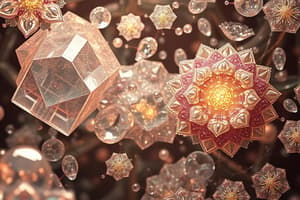Podcast
Questions and Answers
Which of the following is an amorphous solid?
Which of the following is an amorphous solid?
- Silicon carbide
- Chrome alum (correct)
- Graphite
- Quartz glass
Which of the following statements is not true for amorphous solids?
Which of the following statements is not true for amorphous solids?
- They become crystalline on heating at certain temperatures
- Amorphous solids can be molded by heating
- They may become crystalline on keeping for long
- They are anisotropic in nature (correct)
What is isomorphism?
What is isomorphism?
- The process of heating to alter the crystal structure
- Two or more substances having the same crystal structure (correct)
- A substance that exists in multiple forms
- Different substances with different crystal structures
What defines polymorphism?
What defines polymorphism?
What is allotropy?
What is allotropy?
Which characteristic properly describes solids?
Which characteristic properly describes solids?
What distinguishes crystalline solids from amorphous solids?
What distinguishes crystalline solids from amorphous solids?
Which of the following is NOT true about amorphous solids?
Which of the following is NOT true about amorphous solids?
Which of the following is a characteristic of crystalline solids?
Which of the following is a characteristic of crystalline solids?
Which of these materials is categorized as a crystalline solid?
Which of these materials is categorized as a crystalline solid?
Flashcards are hidden until you start studying
Study Notes
Solid State Overview
- Solids have a regular and repeated arrangement of atoms, categorized into crystalline and amorphous types.
- Crystalline solids possess a long-range order, while amorphous solids have a short-range order.
Characteristics of Solids
- Hardness: Solids are hard and not easily compressible.
- Rigidity: Fixed shape and volume, maintaining their form under pressure.
- Fixed Composition: Defined mass, volume, and density.
- Particle Arrangement: Particles are fixed in position with vibrational motion.
- Intermolecular Forces: Strong attractive forces lead to short intermolecular distances.
Crystalline vs. Amorphous Solids
| Crystalline Solid | Amorphous Solid |
|---|---|
| Regular geometric shapes | Irregular shapes |
| Sharp melting points | Melt over a range of temperatures |
| True solids | Pseudo solids |
Types of Solids
- Crystalline Solids: Examples include ice, salt (NaCl), and metals (sodium, gold, copper).
- Amorphous Solids: Examples include glass, plastic, and rubber.
Distinct Characteristics
- Amorphous solids can transform into crystalline structures upon heating or aging.
- For crystalline solids, isotropic nature is a significant characteristic, contrasted with the anisotropic properties of amorphous solids.
Isomorphism and Polymorphism
- Isomorphism: Occurs when different substances have the same crystal structure, e.g., NaF and MgO.
- Polymorphism: Different crystalline forms of the same substance exist under varying conditions, e.g., D-quartz and p-quartz for silica.
Allotropes
- Allotropes refer to different structural forms of the same element, a specific case of polymorphism.
Unit Cells in Crystals
- Primitive Cells: Simple cubic unit cells with atoms only at the corners.
- Non-Primitive Cells: Include atoms at corners, faces, and center.
Types of Non-Primitive Unit Cells
- Body-Centered: Atoms at all corners and center.
- Face-Centered: Atoms at all corners and center of faces.
- End-Centered: Atoms at corners and two opposite faces.
Packing Efficiency
- Calculated using the formula for volume:
- Body Centered Cubic (BCC) packing efficiency is 68%.
- Face Centered Cubic (FCC) packing efficiency is 74%.
Types of Crystalline Solids
| Type | Properties | Examples |
|---|---|---|
| Ionic | Hard and brittle, high melting points, poor conductors in solid state | NaCl, CaF |
| Covalent | Very hard, high melting points, poor electrical conductors | Diamond, Silica |
| Molecular | Soft, low melting points, good thermal and electrical conductors | Ice, Benzoic acid |
Crystal Systems
| Crystal System | Length | Angles |
|---|---|---|
| Cubic | a = b = c | α = β = γ = 90° |
| Rhombohedral | a = b = c | α = β = γ ≠ 90° |
| Tetragonal | a = b ≠ c | α = β = γ = 90° |
| Hexagonal | a = b ≠ c | α = β = 90°, γ = 120° |
| Orthorhombic | a ≠ b ≠ c | α = β = γ = 90° |
| Monoclinic | a ≠ b ≠ c | α = β = 90°, γ ≠ 90° |
| Triclinic | a ≠ b ≠ c | α ≠ β ≠ γ ≠ 90° |
Key Relationships
- Molar mass, density, and edge length of a unit cell are interrelated through mathematical expressions that can be used for calculations in quantitative assessments.
Important Formulas
- Packing efficiency = (Volume of spheres / Total volume) x 100.
- Void space = 100% - Packing efficiency.
Questions for Understanding
- Identify primitive unit cells based on edge length and angle variations.
- Recognize the Bravais lattices corresponding to different crystal systems.
These notes provide a comprehensive overview of solid-state chemistry, emphasizing key concepts and definitions essential for understanding.
Studying That Suits You
Use AI to generate personalized quizzes and flashcards to suit your learning preferences.




